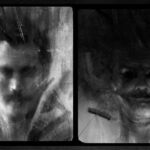The Special Challenges of Attempting a New Translation of Kafka
Mark Harman on Learning to Understand Both the Surfaces and “Subterranean Passages” of Kafka
Kafka claims in a letter to Milena Jesenská, his girlfriend and first translator, that the emotional cohesion of “The Judgment” is evident in “every sentence, every word, every—if I may say so—music.” Kafka could hear that “music” in Jesenská’s Czech translation, although he would have initially preferred to hear the voice of his beloved: “I wanted to hear from you and not the voice from the old grave, the voice I know all too well.”
His high praise of Jesenská’s translation could only have come from a polyglot writer, who spoke Czech in addition to his native German, had a sophisticated understanding of the translator’s task, and whose writing straddles linguistic and cultural boundaries.
Anyone who attempts a new translation of Kafka owes a great debt to the work of Willa and Edwin Muir, who created the remarkably elegant, and, for the better part of the twentieth-century, canonical English-language translations of Kafka. As first translators, the Muirs needed to introduce their unsettling author to English-speaking readers and creatively adapted some of Kafka’s stylistic idiosyncrasies.
We latter-day translators of this now classic modern writer are perhaps a little freer to stretch English in our inevitably less than successful attempts to echo Kafka’s austere music, his singular voice, and his rhythmic accumulation of logically sequenced detail. For, as Milan Kundera reminds us in an essay on French translations of The Castle, “every author of some value transgresses against ‘good style’ and in that transgression lies the originality (and hence the raison d’être) of his art.”
I would add that we translators, and indeed readers, too, need to pay close attention not only to the surface of Kafka’s stories, but also to what he, in a letter to Jesenská, calls their “subterranean passages.”
Although Kafka absorbed the work of an eclectic assortment of classical and modern writers—Johann Wolfgang von Goethe, Heinrich von Kleist, Adalbert Stifter, Charles Dickens, Gustave Flaubert, Fyodor Dostoevsky, and Robert Walser—he developed a unique style, which owes something to the precise, limpid prose that he honed in his official reports at his day job as a lawyer.
In his fiction, he manages to sound at once dry and impersonal while retaining many of the idiosyncrasies that are familiar to readers of his diaries and letters. His is often a diffident voice which keeps questioning itself, retracting even hesitant assertions. His style in these stories ranges from the stately prose in the opening lines of “The Judgment” to the dramatic and almost cinematic as well as occasionally bureaucratic style of “The Transformation” through the painful precision and evasive obfuscation of “In the Penal Colony” to an ape’s humorously pedantic and slightly stilted speech in “A Report for an Academy.”
In translating the stories in Selected Stories, I have resisted the temptation to make the English more vivid, expressive, and colorful than Kafka’s plain and understated German. That plainness was a deliberate choice, a rejection of the “high-flown stuff” (almost none of which has survived) that he wrote as a youth while he still was, as he put it, “mad about grand phrases.”
Kafka’s usually clear and dispassionate tone—Samuel Beckett, who read The Castle in German, called it “almost serene”—heightens the uncanniness of the events depicted in his stories while also enabling us readers to detach ourselves from the protagonist and to perceive layers of irony and, yes, humor hidden in the interstices of his sentences.
A translator’s effort to recreate the disparate effects of these styles is at least partly foredoomed by the distance between languages, even those so closely related as are English and German. Take, for instance, syntax: Kafka, and indeed German literary convention, is famously partial to long sentences, which I have tried to mimic, even though they challenge contemporary English-language preferences.
Kafka’s blurring of the line between the perspective of the generally unobtrusive narrator and that of the main character, through whose point of view many of the stories in this selection are largely told, poses another challenge for the translator. Even within the same sentence Kafka can switch back and forth between those two perspectives, and the narrator’s drily impersonal diction often gives way to the more colloquial language that conveys the protagonist’s thoughts and ruminations.
In stories told in the first-person, there are some abrupt changes of tense, from past to present, which are as startling in German as they are in English. I have also tried to reflect, at least partly, Kafka’s shifting choices when it comes to punctuation: while sparse and mostly reliant on commas in some stories, in others such as “The Transformation” it can be quite heavy, with abundant semicolons.
Another challenge for the translator is how to render little words informally known as “flavoring particles,” which carry a range of possible meanings, such as wohl (perhaps, probably, indeed) and doch (however, but, indeed, after all). Whereas careless writers of German sprinkle such words into their writing with abandon, Kafka deploys them with characteristic precision and so the translator needs to figure out from the context which of the multiple meanings of those little words makes the most sense.
The stories, arranged in the sequence in which they were written, include some of Kafka’s best-known tales and others which are not quite so familiar. The emphasis is on stories written between 1912, the year in which he wrote “The Transformation” (usually translated as “The Metamorphosis”) and “The Judgment,” and 1924, the year of Kafka’s premature death of tuberculosis at the age of forty. My translation generally follows the German critical editions, which have removed the stylistic varnish, as it were, added by Max Brod, Kafka’s close friend, posthumous editor, and first biographer.
The format of this volume has fortunately allowed me to alert readers to otherwise untranslatable features of the original text such as double meanings and verbal leitmotifs, as well as to supply some contextual information. Although the notes reflect my long-standing interest in Kafka’s creative process and in the complex relationship between his life and his art, I have also sought to suggest some of the wide range of interpretations that his stories have elicited.
While working on this project, I kept discovering new things about Kafka that I had missed in four decades reading, teaching, and writing about his work. My hope is that readers of will also make their own discoveries as they find their way through those “subterranean passages.”
______________________________

Excerpted from Selected Stories by Franz Kafka, translated and edited by Mark Harman, published by The Belknap Press of Harvard University Press. Copyright © 2024 by Mark Harman. All rights reserved.




















